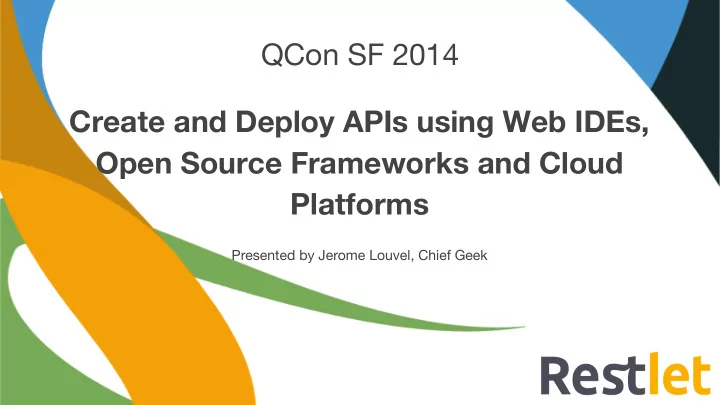

QCon SF 2014 Create and Deploy APIs using Web IDEs, Open Source Frameworks and Cloud Platforms Presented by Jerome Louvel, Chief Geek
New API Landscape Multiplicity of HCI modes Mobile and contextual Always-on and access to services instantaneous services API project Cross-channel user Semantic web experiences (hyperdata) Cloud computing (IaaS)
Impacts on API development End-users ● New types of APIs ○ internal & external APIs Partner devs User Interfaces ○ composite & micro APIs (frontends) ○ experience & open APIs Experience APIs Open APIs (backends) (public) ● Number of APIs increases Composite APIs ○ channels growth (domain services) ○ history of versions Micro APIs Micro APIs ○ micro services pattern (domain data & logic) (external SaaS) ○ quality of service Platform APIs (PaaS) ● → Industrialization needed Infrastructure APIs ○ new development workflows (IaaS)
New API development workflows ● API-driven approach benefits API source code ○ a pivot API descriptor ○ server skeletons & mock generation ○ up-to-date client SDKs & docs introspect generate ○ rapid API crafting & implementation API descriptor ● Code-first or API-first approaches ○ can be combined using ■ code introspectors to extract generate generate ■ code generators to resync API Client docs SDKs
Crafting an API ● Specialized API crafting tools ○ code editors ○ visual designers ○ generation of ■ contract ■ client SDKs ■ skeletons ● New generation of tools ○ IDE-type ○ Web-based
Crafting an API with Restlet ● Browser-based IDE for API crafting ○ accelerate the design of APIs ○ Chrome extension ○ compatible with other modern browsers ● Supports ○ visual design of APIs ○ source code views Preview Launch ○ APIs with large # of resources (sections) November 18th ○ skeleton and SDK generation ○ adherence to REST ○ multiple API languages (Swagger & RAML initially)
Implementing an API ● Implementation using a RESTful API framework ○ Benefits ■ less mental gap compared to MVC & RPC frameworks Custom web API ■ higher level than raw HTTP libraries (Servlet, Netty) ■ easier to use HTTP protocol features REST framework ■ open source (no lock-in) HTTP ○ Key features of an API framework semantics ■ API descriptor/contract definition HTTP / WebSocket ● in Java, typically uses annotations transport ■ both client and server side support ■ make it easy or transparent to use HTTP features ■ performance and scalability
API Frameworks Landscape ● JAX-RS centric ○ Oracle Jersey ○ JBoss RESTeasy ○ DropWizard ○ Apache Wink ○ Apache CXF ● Alternative Java APIs ○ Restlet Framework ■ favor Restlet API ■ support JAX-RS API ○ REST.li ○ RESTx ○ REST Express ● JavaScript ○ Express.js
Implementing an API with Restlet ● All HTTP features supported ○ caching, content ranges & compression ○ content negotiation & conditional requests ○ confidentiality & authentication ○ all HTTP headers mapped to Java classes ● What’s New in v2.3? Version 2.3.0 launch ○ API introspector (Swagger, RAML, WADL) November 18th ○ API management (API firewall, APISpark integration) ○ @Status annotation (map Java exception & HTTP error) ○ CORS support (cross-origin access) ○ easier access to raw HTTP headers ○ upgrade to Jetty 9.2 with client-side support ○ compatible with Java 7, GWT 2.7, Android, GAE, Java EE, OSGi
Restlet-annotated Java interfaces
JAX-RS and Restlet APIs | Server-Side
JAX-RS and Restlet APIs | Client-Side
Deploying an API ● PaaS make it easier to deploy ○ less operational burden ○ cost and time effective to start then scale ○ more availability and lower latency ■ necessary for a global reach ● Generic Infrastructure PaaS ○ hosting and auto-scaling ○ good density thanks to VMs ○ better density thanks to containers (Docker) ● Specialized PaaS for APIs ○ add API management on top of the hosted API ○ integrate with Infrastructure PaaS ■ remote agent close to API or API wrapper
Managing an API ● Typical Benefits ○ documentation ○ access control ○ firewall ○ adaptation ○ monetization ○ analytics ● APISpark Supports ○ APIs with large # of resources (sections) ○ skeleton and SDK generation ○ integration with Restlet Framework General Availability November 18th
Conclusion ● APIs enable new abstracting layers ○ IaaS became a game changer thanks to APIs ■ S3, EC2, Route53, etc. ○ PaaS is the next game changer ■ thanks to APIs as well!
Thank you
Recommend
More recommend